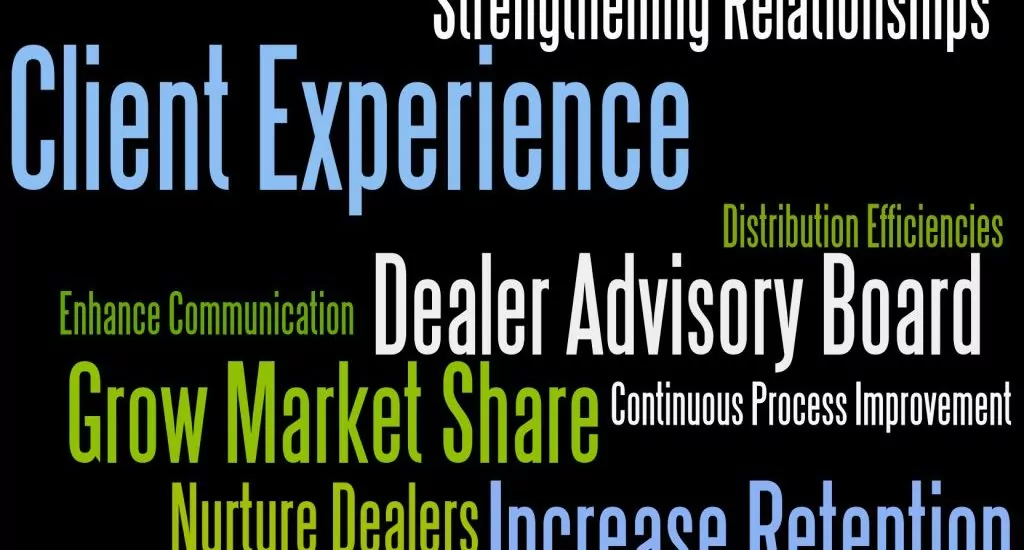- August 2, 2018
- Posted by: Hillary Feder
- Category: Customer Engagement

Improving the Client Experience from the Inside Out and Outside In
How a new client advisory board and improved internal communications are making a construction materials manufacturer for residential, agricultural, commercial, and cold storage facilities overcome issues limiting efficiency, productivity, and growth.
One thing often leads to another. And that’s how a VP of Marketing’s email inquiry (on New Year’s Day of all days) about our gifting options morphed into a discussion about trade show ROI, a dearth of internal communications, and other issues facing this national company that serves hundreds of dealers across the U.S.
As is often the case, our initial conversation revealed that gifting was only a small piece of the picture. After asking many questions to understand how the company intended to use gifting, we zeroed in on these key needs and objectives:
- The company’s top priority was to increase dealer retention and grow market share without expanding the dealer network; how could the company help current dealers win more clients and grow their business.
- The company had acquired two additional facilities in two different states, yet there was no structured internal communications among the three facilities and consequently no process for sharing information that could improve production and distribution performance; facilities were also missing cross-functional communication.
- The company lacked a way to evaluate its marketing activities, including the 150 trade shows it funded annually, co-op advertising, website, and direct mail; there was no tracking system for leads once they were in the dealers’ hands.
As I pondered these issues after our call, I had an “aha” moment about how to help the company meet its objective. The company needed to shape a dealer experience that met dealer expectations from the outside in, in other words with the help of dealers themselves; and from the inside out through communications that would improve production and distribution.
Hillary’s presented a recommendation for a Dealer Advisory Board or DAB to serve as the voice of dealer opportunities, concerns, and priorities in an effort to help meet both the company’s and the dealers’ business objectives. Semi-annual meetings would provide opportunities to engage with dealers in a strategic, educational, and fun environment.
The results would be a competitive differentiator that would:
- Enhance communication with the dealer network
- Nurture dealer advocacy
- Inspire a more analytical approach that strives for continual process improvement
What’s more, we envisioned using insights from Dealer Advisory Board meetings to:
- Assess current marketing and communication activities
- Generate ideas for using current practices to get greater results
- Present gaps and barriers resulting from current practices
- Recommend practices that should be dropped and new, meaningful
initiatives
Enter the DAB
When the first 14 dealers we contacted jumped on the opportunity to join the DAB, it solidified just how important the new dealer voice would be in prioritizing opportunities, developing processes and systems, and create efficiency for dealer support efforts. To prepare for our initial meeting, we interviewed DAB members to learn about their challenges in working with our new client as well as their expectations of the company.
The magic began to happen at our first DAB meeting. The ideas began to flow, and we created a “must-do” list for the company in the form of a six-month plan. It included production, communication, marketing, and education tasks designed to address the board’s highest priorities. We documented responsibility ownership, timelines, milestones, checks and balances, and what success would look like for each task. Within the first 30 days following the meeting, we kicked off two key communication initiatives: a monthly cross-function meeting with the CEO and all department heads; and a semi-annual internal event where all 30 DSMs (need to spell out) and general managers of all three plants meet with headquarters executives.
In addition, we planned communication systems designed to bring information more consistently both up and down the chain of command. These systems included:
- Senior leader meetings on a more regular schedule (minimum of 60-90 minute meetings weekly) with closed-loop communication
- Companywide quarterly high-level forums for all employees to hear directly from leadership
- More intimate and informal ways for employees to interact with the CEO with a ‘Breakfast With Bill’, approximately 4-6 times a year
Fostering greater communication and greater availability to interface with leadership helped bring forward new ideas to help to company operationally – and get closer to both dealers and customers — including:
- Including the parts manifest and preliminary drawings at the time of order instead of waiting until the package arrives
- Providing more details and instructions in commercial drawings to reduce customer questions and concerns
In Summary
For companies that sell through a dealer network, a DAB offers a direct route to overcoming issues that may be holding back growth. In exchange for a DAB’s valuable, honest perspectives, companies must be willing to use the information as an outside driver to improve processes and potentially create new systems.
Think a DAB might help your company? Let’s start a conversation. Connect with us today. We’re
experienced engagement builders.
Toll free: 800-742-6800 In Minneapolis/St. Paul: 952-933-8365 email: Hillary@askhillarys.com
